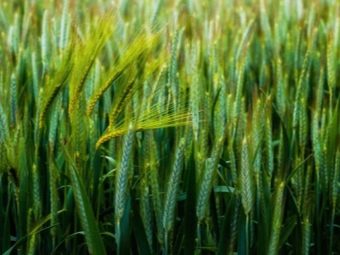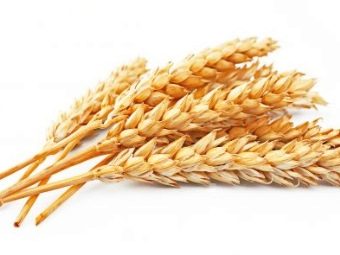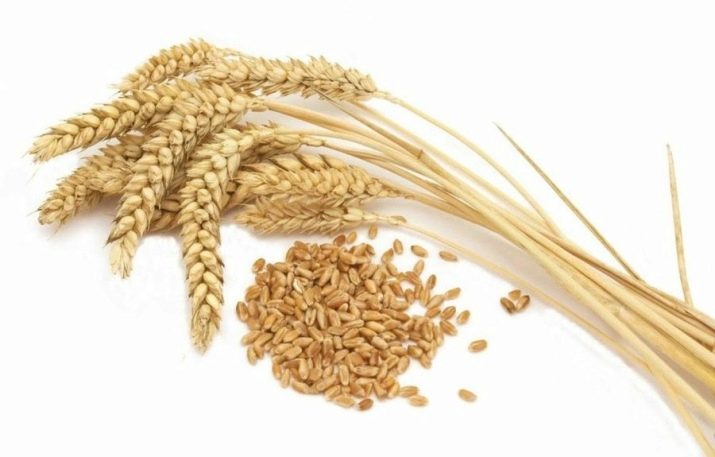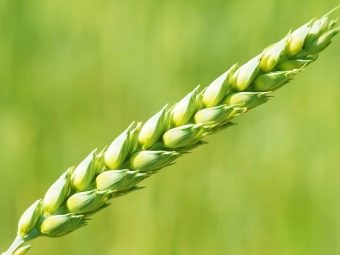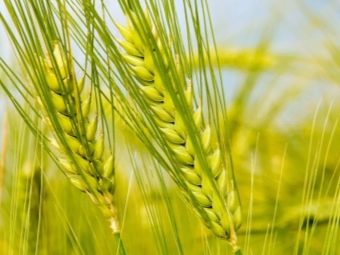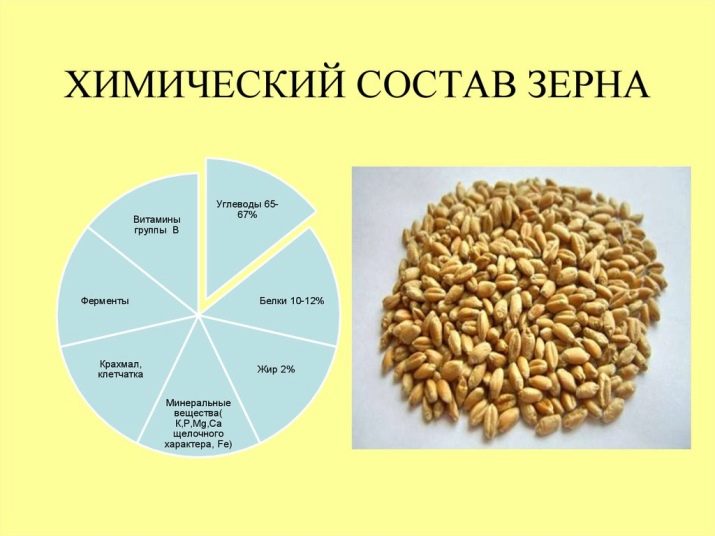Ears of wheat: features, structure and differences from rye
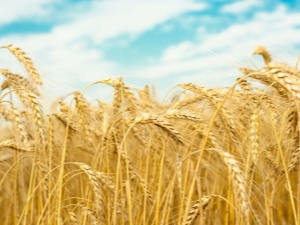
The ear is one of the varieties of inflorescences of angiosperms and consists of an elongated main axis with flowers on it. From the number of flowers depends on the type of ear.A simple type is an ear with the presence of single flowers, and a complex one is represented by several flowers. The ear of wheat, one of the most important food crops, belongs to the second type.
Cereal characteristics
Wheat (lat. Triticum) is one of the brightest representatives of the family of cereals, belongs to the class of monocotyledons and is the first cereal cultivated by man. The place of origin of the culture has long been disputed, but as a result of careful research, it still recognized the city of Diyarbakır, located in Asia Minor.
The stem of the plant has a hollow straight structure with the presence of nodes. Its growth is due to an increase in internodes, the number of which varies from 5 to 7. After the stalk grows out of the vagina of the last leaf, the earing process begins. From each rootless root can grow up to 12 of these stems, reaching a height of one and a half meters each. Wheat leaf is flat, with pronounced fibrous and rough to the touch.
The width of the leaves varies from 1.5 to 2 cm and depends on the variety of wheat and growing conditions. The presence of hairs on leaf blades depends on the variety. The ears are up to 15 cm long and are composed of several flowers, which, in turn, consist of two spikelet scales, two films, a pistil, three stamens and stigmas. The fruit of wheat is grains. Pollination of flowers occurs naturally with the help of the wind.
Wheat is propagated by seeds that are able to germinate four roots simultaneously. After the appearance of the first leaflets, a secondary root system is formed, capable of penetrating into the earth to a depth of 1 meter. Side shoots are formed from nodal roots, and their number can reach up to 5 pieces.
Wheat is produced from flour used to make bakery and pasta products. Ethanol is produced from the grain, and preparations are made from bran to help lower cholesterol and the level of sugar in human blood. As well as culture is the raw material for the production of animal feed, immunomodulatory drugs and rejuvenating extracts.
Spikelet structure
Each of the wheat varieties is distinguished by the features of the spike structure, which in general looks like this: in the mouths of the crankshaft spikes are located on both sides, in which there are flowers under the spikelet scales. Segments are arranged spiral-shaped, which ensures the formation of the site in the upper section. Each site is filled with a spikelet, the location of which is alternate: the first looks to the left, the next - to the right, and so on. Due to this structure, 2 rows are formed on the sides, and on the front part one spike is supported on the other. The color of the ears are white, red, black and gray-smoky.
Spikelet scales is considered one of the important components of the ear: it is by its structure that wheat is classified into varieties. The scales are represented by two wide plates separated in the middle by the keel. In order to determine what kind of wheat, it is necessary to evaluate the scales of the middle part of the spike, since they are not affected by external factors.
The shape of the ears of wheat are divided into several types:
- spindle-shaped is represented by a broad middle, with a gradual narrowing to the upper and lower sections;
- prismatic ear is the same across the width;
- club-shaped expands to the top, for which he received its name.
Grains
Wheat fruit is presented in the form of a single seed grain with a high content of proteins, fats, carbohydrates, starch, disaccharides and dietary fiber. In addition, grains are rich in minerals, vitamins, pectin, phytoestrogens and linoleic acid.
Grain size depends on the growing conditions and varies from 5 to 7 mm or more. The shape of the seeds is also varied.There are grains of oval-elongated, ovate, oval and barrel-shaped forms with square, rectangular, rounded and oval cross sections. The number of grains in the spike also depends on external factors and ranges from 20 to 50 pieces.
Varieties
Wheat is classified according to a number of characteristics, among which are the color of the spike and grains, the presence or absence of spines and pubescence. Spinous species are represented by a coarse, thin and intermediate type of spines, whose properties directly depend on the amount of moisture. Thus, in the most humid areas the awn is tender and soft, and in the more arid regions it is rough and brittle. In relation to the ear, the stems can go in parallel or move to the sides at different angles. The color of the spines also depends on the amount of moisture, and is gray-red with normal moisture, and black with water deficiency.
Wheat is also subdivided into winter and spring species.
- Winter is the most common species and is sown in autumn. Plants differ in fast terms of development and ripening, in which the varieties of spring wheat are significantly ahead. The winter wheat crop is harvested the next summer after sowing. The number of spikelets depends on the variety and varies from 16 to 25. The Mironovskaya Jubilee is considered the most productive, having the highest rate.
- Spring wheat, in contrast to winter, is characterized by a sharper spike of spikelet scales and a long awn on the lower floral scale, which can reach 20 cm. The species is picky about external factors and is quite thermophilic.
Wheat and rye crops - what is the difference?
Wheat and rye are the best-known cultivated cereals and for many years provide humanity with food. However, despite their prevalence, many city dwellers cannot distinguish between these two cultures.
Rye (Latin Secale) is a representative of the family of cereals, and has 12 wild and one cultivated species. The plant is characterized by an erect hollow stalk of a knotted structure, whose height can reach two meters, and gray, sometimes fleecy leaves, reaching 30 cm in length. Ears have a two-row structure and grow up to 15 cm, flowers contain 3 stamens. The rye root system is very powerful, extending two meters deep, which makes it possible to grow a crop on sandy soils. According to its chemical composition, rye grains are very rich in gluten, carbohydrates, vitamins of group B and microelements. Flour is widely used for making bakery products, and young shoots of plants are excellent food for animals.
Despite the fact that wheat and rye have so much in common, there are differences between them.
- Seed color. Wheat grains have a golden hue, while rye seeds are green or greenish gray.
- The structure of the spikelet. Rye has a thin spikelet covered with a long mustache, growing rather thickly. Wheat differs, on the contrary, with a thick ear, whose whiskers completely break off at the moment of grain ripening.
- Plant height Rye often reaches the two-meter mark, while wheat does not grow above one and a half meters. However, due to the large length of the stem, rye often "falls", which causes certain difficulties during harvesting.
- Nutritional value and chemical composition. Flour from wheat is the most nutritious in comparison with rye, and from it more tasty bakery products turn out. In addition, the nutritional value of wheat is much higher than that of rye. However, the caloric content of both cultures is almost the same. Thus, the energy value of 100 grams of wheat grains is 339 calories, while in rye this figure is 338. Proteins in rye make up 8.9%, fats 1.7, and carbohydrates 60.7%. Dietary fiber is present in the amount of 13.2%, and the share of mineral components is equal to 1.9% of the total volume. Wheat also contains 13% of proteins, 2.5% of lipids, 67% of carbohydrates and 10% of dietary fiber.In addition, wheat grains contain a lot of starch and sugar.
Therefore, the nutritional value of wheat exceeds that of rye, which is rightly the product of dietary nutrition.
- Cultivation and care. Both species are grown winter and spring. However, wheat is the most vulnerable species, and does not tolerate severe frosts and the lack of snow. In completely snowless winters, winter wheat may die. This is because the tillering of wheat stalks occurs very low. Rye in terms of adaptation and frost resistance is superior to wheat. The plant is able to withstand 30 degrees of frost and tolerates a complete lack of snow cover. In addition, rye can easily grow on depleted clay and sandy soils, while wheat requires extremely fertile chernozems and podzolic soils. Does not like wheat and high acidity, while rye, this figure does not have such a significant impact.
- Susceptibility to diseases. Compared to rye, wheat is prone to more diseases. So, when overmoistening the soil, the plant is exposed to fungal diseases, while rye they are not terrible. Despite the differences, both wheat and rye are a valuable source of nutrients and have been feeding humanity for many centuries.
On the properties of winter wheat, see the following video.



